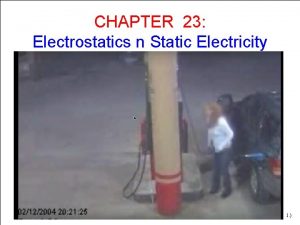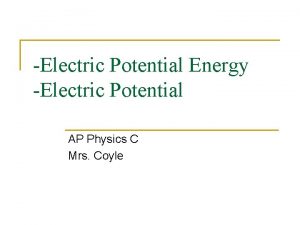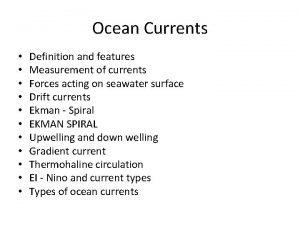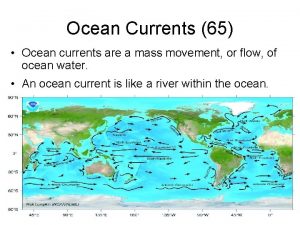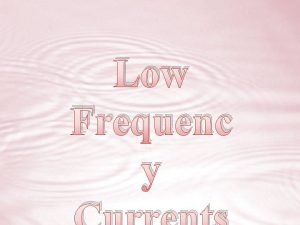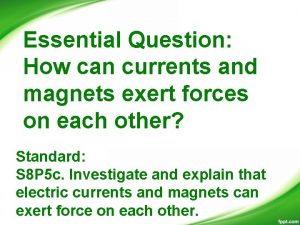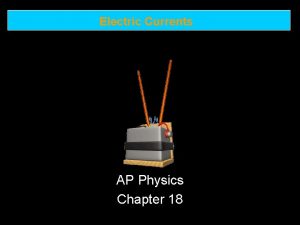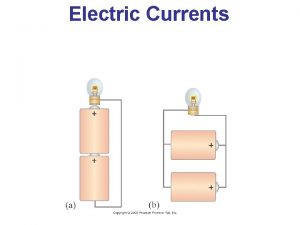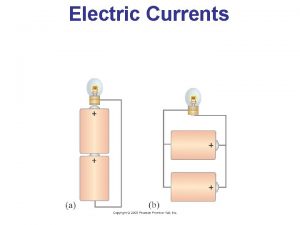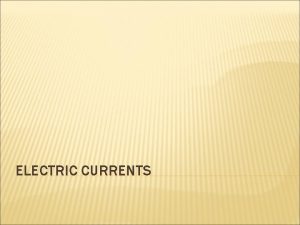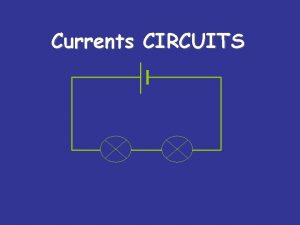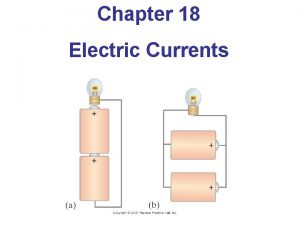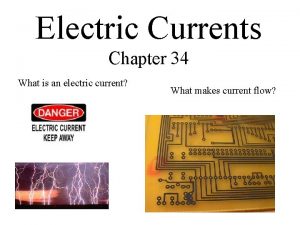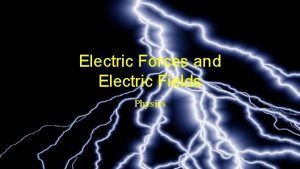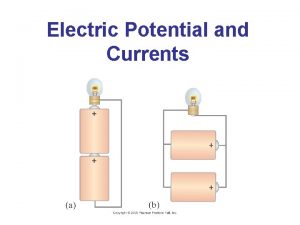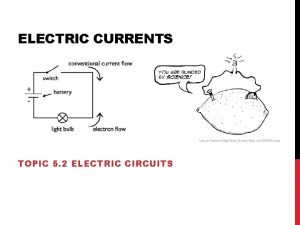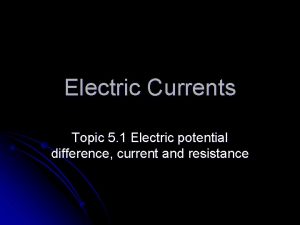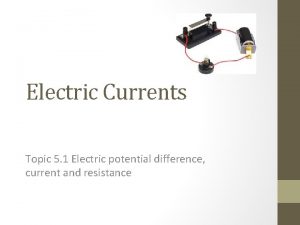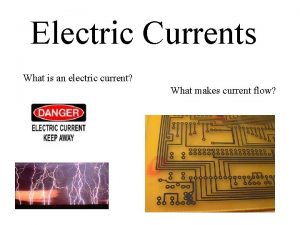Electric Currents AP Physics Chapter 18 Electric Currents



























- Slides: 27

Electric Currents AP Physics Chapter 18

Electric Currents 18. 1 The Electric Battery

The Electric Battery Alessandro Volta – produces the first battery made of zinc, silver, and cloth soaked in salt solution Electric Cell – two plates or rods (electrodes) of dissimilar metal placed a solution (like dilute acid) Battery – several cells connected together 18. 1

The Electric Battery The potential difference (voltage) between the terminals of a cell depend on what the electrodes are made of. Remember half-cell reactions from chemistry When two cells are placed end to end, or in series, their voltages add up 18. 1

Electric Currents 18. 2 Electric Current

Electric Current Circuit – continuous conducting path between terminals of a battery (or other source of EMF) Electric Current – flow of charge (electrons) I – current (amperes) Q – charge (coulomb) T – time 18. 2

Electric Current Ampere (for Andre’ Ampere) Usually called an amp Open Circuit – break in the circuit, no current flow 18. 2

Electric Current Short Circuit – when the load is bypassed Current increase Ground – allows for a continuous path for charge flow 18. 2

Electric Current For historical reasons, current is defined as being in the direction that positive charge flows 18. 2

Electric Currents 18. 3 Ohm’s Law

Ohm’s Law George Simon Ohm The actual values depend on the resistance of the conductor Called Ohm’s Law R – resistance measured in Ohms (W) 18. 3

Ohm’s Law Only true for Ohmic materials Vacuum Tubes, Transistors, Diodes are nonohmic 18. 3

Ohm’s Law A graph of current vs. potential difference The metallic conductor is ohmic The diode and filament are not 18. 3

Ohm’s Law Resistor – anything that uses electric energy Resistor – device used to control current The symbol for a resistor is 18. 3

Ohm’s Law The resistance value of a resistor is indicated by the colored bands on the resistor 18. 3

Ohm’s Law Misconceptions 1. Cells (batteries) do not put out a constant current. They maintain a constant potential difference. 2. Current passes through a wire and depends on the resistance of the wire. Voltage is across the ends of the wire. 3. Current is not a vector, it is always parallel to the conductor. The direction is from + to -. 18. 3

Ohm’s Law Misconceptions 4. Current or charge do not increase or decrease. The amount of charge in one end of the wire comes out of the other end. 18. 3

Electric Currents 18. 4 Resistivity

Resistivity Resistance is found to be directly proportional to its length and inversely proportional to its cross sectional area. ρ is called the resistivity (Wm) Longer extension cords must be thicker to keep resistance low 18. 4

Resistivity Some common resistivity values Material Silver Copper Gold Aluminum Tungsten Platinum Nichrome Resistivity Temperature Coefficient (Wm) (Co-1) 1. 59 x 10 -8 0. 0061 1. 68 x 10 -8 0. 0068 2. 44 x 10 -8 0. 0034 2. 65 x 10 -8 0. 00429 5. 6 x 10 -8 0. 0045 10. 6 x 10 -8 0. 00651 100 x 10 -8 0. 0009 18. 4

Resistivity Best Conductor is Silver, but Copper is close and much cheaper Tungsten is used in filaments Nichrome Apparently an Anime character 18. 4

Electric Currents 18. 5 Electric Power

Electric Power The rate of energy flow for an electric circuit That is more commonly written as Combining with Ohm’s Law it can also be written 18. 5

Electric Power The power company charges by the kilowatthour (k. Wh) Just a cool picture 18. 5

Electric Currents 18. 6 Power in Household Circuits

Power in Household Circuits Household circuits – wires will heat up as current increases In a 20 A household circuit In a 15 A household circuit Circuits are typically designed to run at 80% of the rated power output Different circuits have different gauge wires (diameter) 18. 6

Power in Household Circuits Circuit Breakers and Fuses Break the circuit 18. 6
 What is deep current
What is deep current Electric currents and magnetic fields
Electric currents and magnetic fields Electric currents and magnetic fields
Electric currents and magnetic fields Conceptual physics chapter 35 electric circuits
Conceptual physics chapter 35 electric circuits Conceptual physics chapter 23 electric current
Conceptual physics chapter 23 electric current Chapter 21 electric charge and electric field
Chapter 21 electric charge and electric field Chapter 21 electric charge and electric field
Chapter 21 electric charge and electric field Coloumb units
Coloumb units Units of a charge
Units of a charge Why does it happen
Why does it happen University physics with modern physics fifteenth edition
University physics with modern physics fifteenth edition Physics ia idea
Physics ia idea Magnetic field lines on a bar magnet
Magnetic field lines on a bar magnet Electric field formula
Electric field formula Ap physics c electric potential
Ap physics c electric potential Electric potential due to dipole
Electric potential due to dipole Potential energy of capacitor
Potential energy of capacitor Electric potential electric field
Electric potential electric field A suitable electric pump in an electric circuit is a
A suitable electric pump in an electric circuit is a Electric charges and electric forces lesson outline
Electric charges and electric forces lesson outline Meteorology jeopardy
Meteorology jeopardy Ocean currents waves and tides
Ocean currents waves and tides Coriolis effect vocabulary
Coriolis effect vocabulary Ocean currents definition
Ocean currents definition Upwelling in the ocean
Upwelling in the ocean Low frequency current
Low frequency current Ocean currents map
Ocean currents map Explain how currents and magnets exert forces on each other
Explain how currents and magnets exert forces on each other




